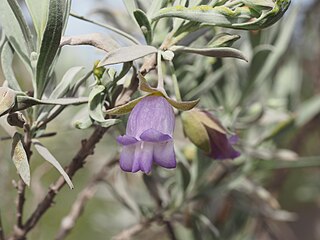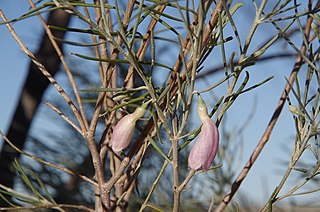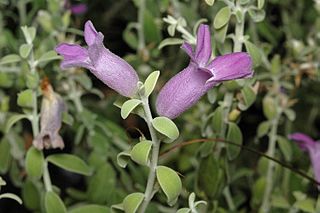
Eremophila bignoniiflora, commonly known as Bignonia emu bush, creek wilga, dogwood, eurah, gooramurra, kurumbimi and river argee is a plant in the figwort family Scrophulariaceae and is endemic to the Northern Territory and all mainland states of Australia. It is a spreading, weeping shrub or small tree with long, strap-like leaves. Its leaves are among the longest in the Eremophila genus and the flowers are also relatively large, reflecting their adaptation to pollination by birds.

Eremophila bowmanii, also known as silver turkeybush, Bowman's poverty bush and flannel bush, is a flowering plant in the figwort family, Scrophulariaceae and is endemic to New South Wales and Queensland in Australia. It is a low to medium, spreading shrub with silvery-grey, hairy foliage and blue to lilac flowers, and sometimes grows in dense thickets with mulga.

Eremophila mitchellii, known commonly as false sandalwood and several other names, is a flowering plant in the figwort family, Scrophulariaceae and is endemic to Australia. It is a glabrous large shrub or small tree with flaky bark, white or cream-coloured flowers and is capable of root suckering. It is widespread and common in New South Wales and Queensland where it is sometimes a serious pest of grazing land, however essential oils from the plant have been shown to have valuable properties and have been commercially exploited.

Eremophila maitlandii, commonly known as Shark Bay poverty bush, is a flowering plant in the figwort family, Scrophulariaceae and is endemic to Western Australia. It is a silvery-grey shrub with linear leaves and lilac-coloured to light purple flowers and is common in coastal areas between Shark Bay and Carnarvon.
Eremophila acrida is a plant in the figwort family, Scrophulariaceae and is endemic to arid areas in the Northern Territory and Queensland in Australia. It is a small shrub with most of its above-ground parts covered with hairs which are tipped with a tiny yellow gland. It has a strong, bitter odour.

Eremophila caespitosa, commonly known as felty-leaved eremophila, is a flowering plant in the figwort family, Scrophulariaceae and is endemic to an area near the centre of Western Australia. It is a small shrub with a tuft-like habit, very hairy grey leaves and lilac to purple flowers.
Eremophila congesta is a flowering plant in the figwort family, Scrophulariaceae and is endemic to a small area in central areas of Western Australia. It is a grey-coloured shrub with crowded, hairy leaves and lilac-coloured flowers which are white inside.
Eremophila cordatisepala is a flowering plant in the figwort family, Scrophulariaceae and is endemic to areas of Queensland and the Northern Territory in Australia. It is a small grey shrub with purple to lilac-coloured flowers which have heart-shaped sepals at their base.

Eremophila dalyana, commonly known as gidgee fuchsia bush, desert fuchsia or ilpengk by Alyawarre people in the Utopia homeland in Central Australia, is a flowering plant in the figwort family, Scrophulariaceae and is endemic to an area of central Australia. It is a broom-like shrub or small tree with thin leaves and pale pink to white flowers. It is found in south-western Queensland, the extreme north east of South Australia and in a small area in the Northern Territory.

Eremophila decussata is a flowering plant in the figwort family, Scrophulariaceae and is only known from several small, disjunct areas in Western Australia and South Australia. It is small, spreading, silvery-grey shrub with soft leaves and lilac-coloured flowers with spots or streaks of purple inside the flower.

Eremophila demissa is a flowering plant in the figwort family, Scrophulariaceae and is endemic to a small area of central Western Australia. It is a low, spreading shrub with small, yellowish grey leaves and branches and mauve to blue flowers.
Eremophila hispida is a flowering plant in the figwort family, Scrophulariaceae and is endemic to Queensland. It is a small shrub with narrow, hairy, clustered leaves, with violet to purple flowers and is restricted to a small area in central Queensland.

Eremophila macgillivrayi , also known as dog bush, is a flowering plant in the figwort family, Scrophulariaceae and is endemic to Australia. It is a shrub with grey foliage, clustered leaves and red, sometimes yellow flowers. The leaf base is twisted so that the leaf surface is usually close to vertical. It only occurs near the border between South Australia and Queensland.

Eremophila magnifica is a flowering plant in the figwort family, Scrophulariaceae and is endemic to Western Australia. It is an erect shrub with large, clustered leaves and large, attractive lilac-coloured or purple flowers, sometimes so densely clustered that they appear like compound heads of terminal flowers.

Eremophila obovata is a flowering plant in the figwort family, Scrophulariaceae and is endemic to Australia. It is a low, compact shrub with lilac to purple flowers growing mainly in the Northern Territory and Queensland but also Western Australia, South Australia and New South Wales.

Eremophila phyllopoda is a flowering plant in the figwort family, Scrophulariaceae and is endemic to Western Australia. It is an erect or spreading shrub, sometimes round or flat-topped with sticky, hairy leaves and flowers ranging in colour from pink or lilac to purple.

Eremophila recurva is a flowering plant in the figwort family, Scrophulariaceae and is endemic to Australia. It is a shrub with hairy grey leaves, large grey sepals and blue, mauve or lilac flowers.

Eremophila rigida is a flowering plant in the figwort family, Scrophulariaceae and is endemic to Western Australia. It is an erect, rigid shrub with thick, hairy, rigid leaves and pale yellowish-cream flowers.

Eremophila stenophylla is a flowering plant in the figwort family, Scrophulariaceae and is endemic to Queensland. It is a broom-like shrub or small tree with narrow leaves and pink to brick-red flowers, which grows in the far south-west of the state.

Eremophila warnesii is a flowering plant in the figwort family, Scrophulariaceae and is endemic to Western Australia. It is an erect, compact shrub with furry leaves, hairy sepals and blue to mauve petals. It is a little-known species, named after the founder of the Eremophila Study Group.















